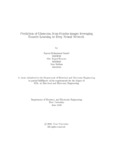| dc.contributor.advisor | Bhuian, Mohammed Belal Hossain | |
| dc.contributor.advisor | Alam, Md. Ashraful | |
| dc.contributor.author | Ismail, Sayem Mohammad | |
| dc.contributor.author | Hossain, Md. Sajjad | |
| dc.contributor.author | Sobhan, Irina | |
| dc.date.accessioned | 2021-03-21T07:03:13Z | |
| dc.date.available | 2021-03-21T07:03:13Z | |
| dc.date.copyright | 2020 | |
| dc.date.issued | 2020-06 | |
| dc.identifier.other | ID: 16321050 | |
| dc.identifier.other | ID: 16321062 | |
| dc.identifier.other | ID: 16121133 | |
| dc.identifier.uri | http://hdl.handle.net/10361/14365 | |
| dc.description | This thesis is submitted in partial fulfillment of the requirements for the degree of Bachelor of Science in Electrical and Electronic Engineering, 2020. | en_US |
| dc.description | Cataloged from PDF version of thesis. | |
| dc.description | Includes bibliographical references (pages 52-55). | |
| dc.description.abstract | Transfer learning techniques in deep learning is nowadays a raising and promising field of research and a tool for Artificial Intelligence with a lot of prospects. Our goal is to predict Glaucoma from fundus images to help the diagnosis procedure of Glaucoma, a public health hazard, at an early stage. In this research, we propose a transfer leaning methodology, creating four models with four pre-trained CNNs implemented separately in each of the models, trained and tested for detecting Glaucoma from fundus images. We have used VGG19, ResNet50, DenseNet121 and InceptionV3 for our transfer learning models, with the fine-tuning approach to ensure better learning performance on our dataset of labelled fundus images. Fine-tuning is done keeping all the layers of pre-trained CNN trainable on the fundus image dataset, and applying the classic method of adding a customized classifier. All the four transfer leaning models are Deep Neural Networks carrying deep hidden layers as the pre-trained CNN implemented. Deep learning application on Biomedical field is itself a challenge to work with due to shortage of labeled data. Thus transfer learning is found very effective in working with a small image data set to predict Glaucoma. Our proposed models built with VGG19, ResNet50, DenseNet121 and InceptionV3 deliver test accuracy of 94.75%, 96.5%, 92.5%, 91.75%. In order to achieve such accuracy in biomedical application, transfer of knowledge of features learned of pre-trained CNNs gave a competitive edge on initialization of parameters. We present comparison amongst the models proposed and the ResNet50 built model gives the best performance. | en_US |
| dc.description.statementofresponsibility | Sayem Mohammad Ismail | |
| dc.description.statementofresponsibility | Md. Sajjad Hossain | |
| dc.description.statementofresponsibility | Irina Sobhan | |
| dc.format.extent | 55 pages | |
| dc.language.iso | en_US | en_US |
| dc.publisher | Brac University | en_US |
| dc.rights | Brac University theses are protected by copyright. They may be viewed from this source for any purpose, but reproduction or distribution in any format is prohibited without written permission. | |
| dc.subject | Glaucoma | en_US |
| dc.subject | Artificial Intelligence | en_US |
| dc.subject | Fundus images | en_US |
| dc.subject | CNN | en_US |
| dc.subject | Transfer leaning | en_US |
| dc.subject | Prediction | en_US |
| dc.subject | Deep learning | en_US |
| dc.subject | VGG19 | en_US |
| dc.subject | ResNet50 | en_US |
| dc.subject | DenseNet121 | en_US |
| dc.subject | InceptionV3 | en_US |
| dc.subject | Finetuning | en_US |
| dc.title | Prediction of glaucoma from fundus images leveraging transfer learning in deep neural network | en_US |
| dc.type | Thesis | en_US |
| dc.contributor.department | Department of Electrical and Electronic Engineering, Brac University | |
| dc.description.degree | B. Electrical and Electronic Engineering | |

